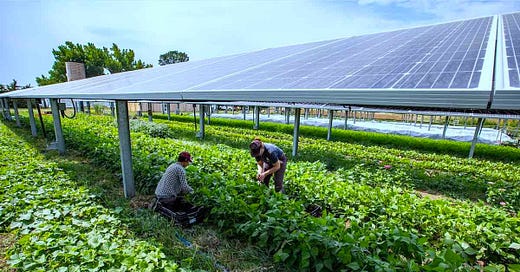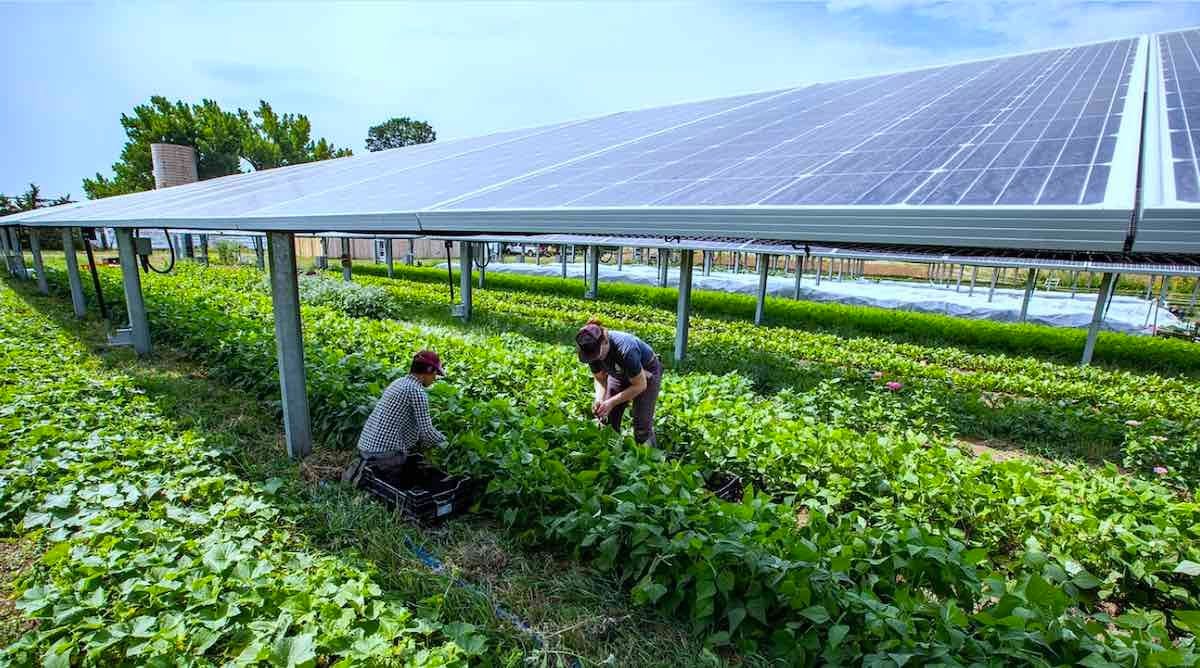Finding Land For Renewables Is a Policy Challenge, Not a Technical Challenge
If we had room for coal mines, we'll have room for solar farms
To power the green transition, we’ll need to find space for a lot of wind turbines, solar panels, hydroelectric reservoirs, and so forth. Last time, I mentioned that we were doing some research on what “a lot” adds up to. Is there a danger of running out of room before we’ve finished displacing fossil fuels?
If land use is a real problem, it won’t show up for a while. To do anything about it, we’d need to see the problem coming well in advance. For that reason, I’m interested in identifying these sorts of scaling limits. Just because solar and wind power installations are skyrocketing today, doesn’t necessarily mean they can take us as far as we need to go.
Land Usage Figures Are… All Over the Map?
The amount of land needed to produce a given amount of electricity depends on how you’re producing it. Check out this chart:

You can gloss over the details. Each red dot indicates a mid-range estimate of the land usage for the corresponding energy source. Note that the numbers for hydropower and nuclear power are 33 and 0.3, respectively: hydropower uses 100 times more land to produce the same amount of electricity. (This despite the fact that the nuclear figure includes “land used for the mining of materials used for its construction, fuel inputs, decommissioning, and the handling of waste”.) This doesn’t mean hydropower is bad; it just means that land requirements will very much depend on our mix of electricity sources.
Renewables Don’t Use Up All The Land They Use
The amount of land used for renewable power depends on your definition of “used”. A certain amount of solar can go on rooftops. Wind power is very dense if you include only the space used by the turbines (“footprint”), but much less dense if you consider the necessary distance between turbines (“spacing”). Fortunately, the space between turbines can often be used for other purposes, such as farming. Solar power can also coexist with agriculture (“agrivoltaics”). Wind turbines can be located offshore, and solar panels can be placed on top of – and provide useful shade for – parking lots, canals, and other surfaces. So depending on the situation and how you look at it, there are three ways to measure the space used for renewable power generation:
Spacing – all of the land involved, including the space between turbines, solar panels, or other units.
Footprint – only the area physically occupied by the generation equipment.
Dedicated1 – footprint, but excluding rooftop solar, solar panels floating on a canal, or other deployments that don’t take away any area from other uses of the land.
When reviewing published statistics for land usage, it’s critical to understand which measurement they’re using. This is touched on at the bottom of the previous chart, which shows that for wind power, the difference between spacing and footprint can be 250:1!
If you want to think about the potential capacity for a given source of energy, you need to use the spacing figures. The wind turbines we build in Nebraska can’t have a total spacing area that’s larger than Nebraska2. But if you want to know how much land will be “used up” for renewables, the “footprint” or “dedicated” figures are more relevant. (This is primarily an issue for wind power. As a result, the exact relevance of spacing vs. footprint will depend on our ability to have wind turbines co-existing with agriculture.)
Doing the Math
Let’s estimate an upper bound on total land requirements for clean electricity.
We found estimates of land usage intensity from three sources: Land-use intensity of electricity production and tomorrow’s energy landscape, Energy Sprawl Is the Largest Driver of Land Use Change in United States, and Decarbonization Won’t Require As Much Land As You Think. Using these figures, we can estimate the amount of land that will be required for electricity production in a net-zero future.
As should be familiar by now to readers of this blog, the sources don’t agree. For the majority of energy types, estimates differ by a factor of 2 or more. One source has the ratio of land usage for solar power vs. geothermal as 3:1; another has 40:1! Our detailed research notes, including some additional sources, are here. At the beginning of that link, you’ll find a small table summarizing the land use figures from each source.
In Energy Consumption in 2050, we estimated an upper bound for global electricity production in 2050 of 300 quadrillion BTUs. That’s about 88,000 TWh.
Setting aside biomass, and using “footprint” figures for wind power, the highest land usage figure we found for any form of energy in any of our sources was 23.5 m²/MWh/y, or 2350 Ha/TWh/y. To produce 88,000 TWh would thus require 207 million hectares. That’s assuming we use only hydropower (one of the least-dense sources), and using the most pessimistic estimate for hydropower land requirements across all three sources. So actual land usage should be much less than 207 million hectares.
As a cross-check, one of our sources provides this diagram, showing land usage for electricity production across a variety of scenarios:
This is a really nice information source, because it shows multiple scenarios and provides error bars. Looking at the scenarios for 2050, and excluding “Renewables (Spacing)” (which, again, is mostly the space between wind turbines), the numbers are generally in the range 100 to 150 Mha – well below our upper-bound estimate of 207. Even when including spacing, estimates range from around 170 to 280.
The first bar (“Current”) shows that today, around 85 Mha is already devoted to electricity production. So our conservative upper-bound estimate of 207 Mha in a net-zero 2050 scenario represents an increase in land usage of around 122 million hectares3 from today.
That’s a lot, but not A LOT a lot
122 million hectares is about twice the size of Texas. So we’re talking about a lot of land. But relative to the Earth, Texas isn’t really all that big. The additional land requirement between now and 2050 is only about 0.9% of the world’s ice-free land area.
(Remember also that this is based on our generous upper-bound estimate of 300 quadrillion BTUs worth of electricity, and taking highest land usage estimate for the least-space-efficient renewable source, hydropower.)
What about spacing for wind turbines? Even if we unrealistically assume that all electricity were to come from wind power, specifically on-shore wind power, and use the highest “spacing” estimate, that works out to 1119 million hectares, or 8.5% of the world’s ice-free land area. That’s less than 1/4 of the land currently used for agriculture (and remember that wind power can often co-exist with agriculture).
Land Use Will Be a Policy Challenge, Not a Physical Challenge
When the outcome is a clean, renewable solution for the entire planet’s electricity needs, it doesn’t seem unreasonable to use an additional 0.9% of the world’s ice-free land area. That’s about 1/40th of what we currently devote to agriculture. (And if we want to reduce overall land use for human activities, we’d do much better to focus on agriculture rather than energy production.)
It’s worth noting that the land requirements for renewables are static, whereas fossil fuels require more land each year: as wells dry up and coal mines empty out, we keep needing to find more. For instance, Germany periodically razes villages to make room for coal mines. In fact, coal power uses almost 2/3 as much land as solar4, even when disregarding rooftop solar. You don’t see much discussion of the land requirements for coal mining. The requirements for renewables won’t be so very much greater.
There will be huge challenges in deploying renewables at this scale, but they won’t take the form of “not enough land”. The challenges will be finding the right kinds of land in the right places, getting permission to use them, connecting them to the grid, and agreeing on who should pay for everything. In other words, policy challenges.
So don’t let anyone tell you that we won’t have enough land for renewable power. Focus on finding policy solutions that will get enough folks on board to allow us to build it.
I’m sure there’s a technical term for this, but I don’t know what it is, so I made one up.
Citation needed.
Of course, there are huge uncertainties in this estimate. Our sources disagree; they don’t all provide confidence intervals; the result depends on how much electricity we actually wind up using, and what mix of sources we use to produce it. But I’ve tried to use conservative-upper-bound estimates for all of those factors.
Taking the geometric mean of the figures from our three sources.





Your opinion pieces are really good to read, I enjoyed them, thanks for sharing!! Can I find you on LinkedIn as well?